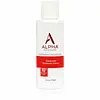What's inside
What's inside
 Key Ingredients
Key Ingredients

 Benefits
Benefits

 Concerns
Concerns

 Ingredients Side-by-side
Ingredients Side-by-side

Water
Skin ConditioningAmmonium Lactate
BufferingC12-15 Alkyl Benzoate
AntimicrobialGlycerin
HumectantPrunus Amygdalus Dulcis Oil
Skin ConditioningEthylhexyl Palmitate
EmollientCetearyl Alcohol
EmollientGlyceryl Stearate
EmollientPEG-100 Stearate
Dimethicone
EmollientHydroxyethylcellulose
Emulsion StabilisingPhenoxyethanol
PreservativeCetearyl Glucoside
EmulsifyingXanthan Gum
EmulsifyingSodium Benzoate
MaskingSodium Stearoyl Glutamate
CleansingTocopheryl Acetate
AntioxidantParfum
MaskingPotassium Sorbate
PreservativePentylene Glycol
Skin ConditioningHydrolyzed Milk Protein
Skin ConditioningDisodium EDTA
Lactic Acid
BufferingSerine
MaskingSodium Lactate
BufferingSorbitol
HumectantUrea
BufferingLinalool
PerfumingCitronellol
PerfumingSodium Chloride
MaskingCitrus Aurantium Dulcis Oil
MaskingLimonene
PerfumingCoumarin
PerfumingJuniperus Mexicana Oil
MaskingAlpha-Isomethyl Ionone
PerfumingAllantoin
Skin ConditioningPelargonium Graveolens Oil
MaskingGeraniol
PerfumingWater, Ammonium Lactate, C12-15 Alkyl Benzoate, Glycerin, Prunus Amygdalus Dulcis Oil, Ethylhexyl Palmitate, Cetearyl Alcohol, Glyceryl Stearate, PEG-100 Stearate, Dimethicone, Hydroxyethylcellulose, Phenoxyethanol, Cetearyl Glucoside, Xanthan Gum, Sodium Benzoate, Sodium Stearoyl Glutamate, Tocopheryl Acetate, Parfum, Potassium Sorbate, Pentylene Glycol, Hydrolyzed Milk Protein, Disodium EDTA, Lactic Acid, Serine, Sodium Lactate, Sorbitol, Urea, Linalool, Citronellol, Sodium Chloride, Citrus Aurantium Dulcis Oil, Limonene, Coumarin, Juniperus Mexicana Oil, Alpha-Isomethyl Ionone, Allantoin, Pelargonium Graveolens Oil, Geraniol
Water
Skin ConditioningGlycolic Acid
BufferingAmmonium Hydroxide
BufferingGlyceryl Stearate
EmollientPEG-100 Stearate
Propylene Glycol
HumectantPEG-40 Stearate
EmulsifyingSorbitan Stearate
EmulsifyingCetyl Alcohol
EmollientIsopropyl Palmitate
EmollientTocopheryl Acetate
AntioxidantPetrolatum
EmollientDimethicone
EmollientMyristyl Myristate
EmollientStearic Acid
CleansingMagnesium Aluminum Silicate
AbsorbentCellulose Gum
Emulsion StabilisingSorbic Acid
PreservativeBHT
AntioxidantImidazolidinyl Urea
PreservativeWater, Glycolic Acid, Ammonium Hydroxide, Glyceryl Stearate, PEG-100 Stearate, Propylene Glycol, PEG-40 Stearate, Sorbitan Stearate, Cetyl Alcohol, Isopropyl Palmitate, Tocopheryl Acetate, Petrolatum, Dimethicone, Myristyl Myristate, Stearic Acid, Magnesium Aluminum Silicate, Cellulose Gum, Sorbic Acid, BHT, Imidazolidinyl Urea
 Reviews
Reviews

Ingredients Explained
These ingredients are found in both products.
Ingredients higher up in an ingredient list are typically present in a larger amount.
Dimethicone is a type of synthetic silicone created from natural materials such as quartz.
What it does:
Dimethicone comes in different viscosities:
Depending on the viscosity, dimethicone has different properties.
Ingredients lists don't always show which type is used, so we recommend reaching out to the brand if you have questions about the viscosity.
This ingredient is unlikely to cause irritation because it does not get absorbed into skin. However, people with silicone allergies should be careful about using this ingredient.
Note: Dimethicone may contribute to pilling. This is because it is not oil or water soluble, so pilling may occur when layered with products. When mixed with heavy oils in a formula, the outcome is also quite greasy.
Learn more about DimethiconeGlyceryl Stearate is a mix of glycerin and stearic acid.
It is used to stabilize the mixing of water and oil ingredients. By preventing these ingredients from separating, it can help elongate shelf life. It can also help thicken the product's texture.
As an emollient, it helps soften skin and supports barrier-replenishing ingredients.
In cosmetics, Glyceryl Stearate is often made from vegetable oils or synthetically produced.
This ingredient may not be fungal-acne safe
Fun fact: The human body also creates Glyceryl Stearate naturally.
Learn more about Glyceryl StearatePeg-100 Stearate is an emollient and emulsifier. As an emollient, it helps keep skin soft by trapping moisture in. On the other hand, emulsifiers help prevent oil and water from separating in a product.
PEGS are a hydrophilic polyether compound . There are 100 ethylene oxide monomers in Peg-100 Stearate. Peg-100 Stearate is polyethylene glycol ester of stearic acid.
Tocopheryl Acetate is AKA Vitamin E. It is an antioxidant and protects your skin from free radicals. Free radicals damage the skin by breaking down collagen.
One study found using Tocopheryl Acetate with Vitamin C decreased the number of sunburned cells.
Tocopheryl Acetate is commonly found in both skincare and dietary supplements.
Learn more about Tocopheryl AcetateWater. It's the most common cosmetic ingredient of all. You'll usually see it at the top of ingredient lists, meaning that it makes up the largest part of the product.
So why is it so popular? Water most often acts as a solvent - this means that it helps dissolve other ingredients into the formulation.
You'll also recognize water as that liquid we all need to stay alive. If you see this, drink a glass of water. Stay hydrated!
Learn more about Water